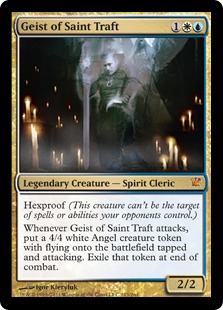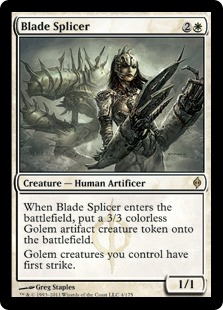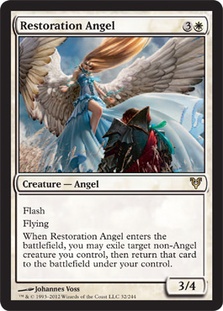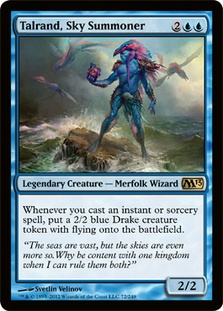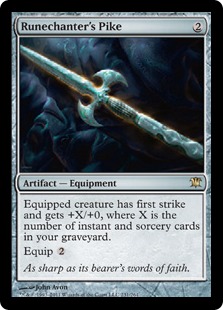“It doesn’t matter where you are, you are nowhere compared to where you can go.”
—Bob Proctor
Change. It’s the most important aspect of Magic, one that deckbuilders hold closest to their hearts. The world around us is constantly in flux; how we react to the constant change is what we call progress. Without progress, without inspiration, without change, we are doomed to repeat past failures, and our past accomplishments will become stagnant and worthless.
Change is an important part of Magic because the game can alter radically with the release of every new set. Each new mechanic is a challenge we must build around. Each new creature type is a workstation where we try to find better interactions that fit their unique cultures. Each new spell and land they make gives us the inspiration we need to create something better than what came before.
The people around us and their decks can change as well. Their card choices will swing dramatically to combat specific changes in dominant archetypes, and in turn we change something about our decks to fight back. It is a never-ending cycle and one of the reasons why Constructed Magic is unlike anything I’ve ever encountered.
Constructed is alive.
Even if one deck is dominant in a given format, you will see others rise to the top. Predators. These are the decks that prey specifically on the “best” deck, ultimately turning themselves into the next big target. You can see this happen pretty regularly in Standard, and the current format is no different. You will hear so many people rattle on about how Delver is the best deck and nothing can beat it consistently. Those people are generally spouting nonsense.
I would venture to guess that most versions of Delver don’t fare well against Zombies, yet you don’t see too many of the game’s better players picking up the undead horde. Why is that? The argument I hear most often is that decks like Zombies tend to leave too much up to the draw since they don’t really have card selection at their disposal. The best players in the room aren’t going to rely on their draw step to get the job done. They want card advantage. They want the ability to outplay their opponent. They like to think they’re smart. Well…
“I’ve yet to meet someone who can outsmart a bullet.”
While I do think Delver is usually the best choice for a given tournament, there are a lot of factors to take into consideration:
- Do you tend to choose aggro-control?
- Do you have a lot of experience playing Delver?
- Do you have the best list for a given tournament?
These are three of the most important factors to take into consideration. For me, Delver is the only choice in Standard right now, but there are so many factors for others to think about! Each deck you play should be different for each tournament, and especially so when those tournaments are wildly different in structure. For example, I would never play the same deck at a Pro Tour that I played at an SCG Open Series. The types of players and the types of decks that are going to show up will be vastly different. Even if you end up playing the same archetype, you should always take into consideration the competition and react accordingly.
At the StarCityGames.com Invitational in Atlanta coming up next weekend, I expect to see a lot of Delver decks. This means that you either need to be playing the best Delver list possible or be playing a deck that preys on Delver decks. Either choice is fine, and it really just depends on what fits your play style best. I will be playing Delver, but my list will differ based on the data I collect over the next week or so and my interactions with other players that will be attending the event. While I’m confident in making these decisions, that doesn’t mean I’m always right. For instance…
I think Zombies will be a fantastic choice for the SCG Open Series Invitational.
Cavern of Souls in conjunction with Geralf’s Messenger is very difficult for Delver decks to handle. It is generally tough to race that kind of pressure, and Zombies will most likely have a lot of removal at their disposal to kill Delvers and such, whereas Delver’s removal like Gut Shot and Vapor Snag have a much smaller impact. With that said, people who are playing Delver will be prepared, but that doesn’t mean Zombies will have too much trouble taking the first game. While sideboard games could prove a bit more worrisome, being advantaged in the first game can be invaluable.
This is all just speculation of course. Every decision in deck choice and deckbuilding should be a reflection of your intuition and the data you’ve collected. Every tournament result posted online should ultimately affect your decisions down to each card you decide to put in your deck. Every article written about each format should help you figure out just what cards you want to play based on what decks you think will be popular. That isn’t to say that everyone who writes an article is always right. Quite the contrary. However, each piece of information is influential, for better or for worse, and you should use that information to your advantage. Picking through this sea of information to find the most relevant bits is a key component to becoming a better Magic player and having more success at tournaments.
…
This past weekend, I played Delver at the SCG Classic Series in Birmingham. I made a conscious decision before the tournament that Delver was going to be the deck that would give me the best result. I just needed to build it correctly to give it a better chance against some of its bad matchups. With that said, the deck still has a few holes that need to be fixed, but I feel like my new list made up for a lot of its previous shortcomings.
First of all, I want to say that U/G Delver was excellent for a time. I’m not sure exactly what threw me off of it, but I think it was probably the fact that Zombies was (for the lack of a better term) eating me alive. U/G Delver doesn’t have the sideboard options to handle the ravenous horde like U/W or even U/R. Without access to Pillar of Flame or Celestial Purge, I found myself falling victim to their powerful threats and efficient removal.
A lot of the more popular versions of Zombies were playing Birthing Pod, which meant they were bringing a million Clones to the party. Thragtusk was not an option anymore, as U/G Delver didn’t have a lot of great ways to handle an opposing Thragtusk. When they copied mine, I felt like I was always losing even when I had an “answer,” which usually meant using a Vapor Snag and a Snapcaster Mage to take care of it. Oh yeah, and they gained five life in the meantime.
Since Thragtusk wasn’t really an option, it was time to switch back to something a little more tried and true. Celestial Purge had always been good to me, and I knew it was the card I wanted most against them, even over Knight of Glory. Since they were coming with a little more heat in Birthing Pod, I couldn’t always rely on Knight of Glory to stop their assault. They could just burn me out from 10+ life with Messengers, Clone variants, and Blood Artist. That isn’t a fight you want to be slugging through without removal, and Celestial Purge was the strongest answer.
White also gives you access to this guy.
You remember this guy, right? For some reason, a lot of people have cut him lately in favor of Augur of Bolas, but I’ve never really been a fan of playing Maritime Guard in my aggro decks. Geist of Saint Traft is still absurd, and it really doesn’t matter how many Clones are in the format. Geist of Saint Traft is one of the most efficient threats ever printed, and it hits hard.
Blade Splicer took his place for a time, pairing up with Restoration Angel to create a lot of Golem tokens. That was pretty sweet before everyone started to play Bonfire of the Damned. Nowadays, you need to kill your opponent as fast as possible, and you can’t rely on a few Golems to do that for you. Not in a world with Thragtusk, and not in a world where Restoration Angel is one of the better creatures.
Clogging up the board is what Bonfire decks tend to do, and for good reason. Those decks rely on Bonfire to clear the board once they’ve established an insurmountable board state. You can’t fight them at this because their deck is so much better suited for this type of game. For every Blade Splicer you have, they have Blade Splicer, Huntmaster of the Fells, and Thragtusk! They can match you on Restoration Angels, so you need to have a functionally different game plan if you want to beat them. This means hitting them hard and fast. Geist of Saint Traft does exactly that.
But Geist of Saint Traft isn’t always enough. Sometimes your opponent just throws so many creatures into play that you can’t remotely compete. Restoration Angel isn’t going to dig you out of that situation, so what are you going to do?
Previously, these were our options:
This combination of threats was synergistic and helped fight off a lot of the aggro decks when Restoration Angel first came onto the scene. However, with the way that aggro decks are built now, I don’t think it’s powerful enough.
This combination, while utilizing less synergy, allowed you to play a more powerful threat at the three-drop slot. Restoration Angel was still “good,” but not that good. However, it was still a 3/4 flier with flash that gave you a lot of upside in the middle of combat.
It has taken me this long to put two and two together.
These two threats are wildly different at what they do, but the trick is that they are both the most powerful at what they do. When your opponent has an answer to Geist of Saint Traft, a lone Restoration Angel isn’t likely to get the job done. Talrand, Sky Summoner can win games that both Restoration Angel and Geist of Saint Traft can’t. It generates blockers and threats simultaneously, fending off opponents while also killing them. With so many decks trying to clog up the ground, it’s only fitting that we take control of the skies!
Sure, Bonfire of the Damned is still a card. If they have it, they’re likely using it early to kill off Delvers, Snapcaster Mages, and Geists. If they happen to draw multiples and you haven’t disrupted their mana enough by killing their Birds of Paradise and such with your Gut Shots or drawn a Mana Leak, then so be it. Talrand isn’t here for this matchup. Talrand is here to win the grindhouse games. He’s here to win the games that no other threat in your deck could win. He’s here to take control of the game and never give it back.
As of late, I’ve said on multiple occasions that I rarely lose when I get to untap with a Talrand. Usually, I’ll try to stock up on a few free spells to gain instantaneous value, but that isn’t always a luxury you have with Delver. You need to cast your spells to stall your opponent, hit your land drops, and keep the pressure coming. However, when you get to untap with Talrand, you gain a lot of potential to win the game. Each spell that draws a card threatens to generate another creature, and each Ponder is almost a guarantee that you’re getting a second Drake. When you’re using Snapcaster Mage alongside Talrand, things just start getting dirty.
So if we’re building around Talrand and Geist of Saint Traft, what other changes are we making? With adding this many cards to a deck, there are obviously some significant cuts to be made. For one, I’m just done with this card:
So many people have told me how good Runechanter’s Pike is. I can’t even begin to tell you how much I hate it. Runechanter’s Pike is a trap. It is a crutch that people use because they’ve seen other people use it to great effect. Runechanter’s Pike is good when your creatures are not good. When your creatures are good enough, you just don’t need another card to make them good.
With Talrand and Geist of Saint Traft as the heavy hitters, this is exactly how I feel. I don’t think that Runechanter’s Pike is necessary because your creatures get the job done on their own! Just because it makes your Geist of Saint Traft harder to block or makes your Delvers and Snapcaster Mages hit harder doesn’t mean it’s worth playing. Those cards are good enough on their own, and if you had better spells in place of Runechanter’s Pike, you wouldn’t need Runechanter’s Pike in the first place!
This was my logic going into the Birmingham Classic, and here is the list I played thanks to that reasoning.
Creatures (15)
Lands (20)
Spells (25)

Obviously, there are some significant differences between this list and the ones we are used to seeing. There are no Restoration Angels. No Pikes. You can see a few sweet new (old) additions to help protect our fishy friend. Talrand is an awesome card, and it’s one that can easily dominate decks that don’t have a lot of sweepers at their disposal. Most decks will focus their attention on your early threats like Delver of Secrets, leaving your late-game legends to mop up after most of the damage is done. While Runechanter’s Pike does have its advantages, I highly recommend giving this list a try.
I hope that my reasoning above is enough to convince you to make these changes, but I understand the draw of familiarity. After having played with this list for a few events, I’m not looking back. To me, this is the best Delver list in Standard and at least the start of the last era of Delver before the Return to Ravnica. There are still a few major events coming up before rotation, and I think this list is relevant enough to talk about before we get into full-blown spoiler mode.
…
Over the next few weeks, the entire set of Return to Ravnica should be spoiled. This means new decks for a new Standard, new videos featuring sweet new cards, and new articles churning out a ton of important information. I will be joining in on this myself, and I even started last week by highlighting a few of my personal favorites thus far.
We will be attempting to create video content using the new cards, but that will involve using proxies until the set is physically released. We might also mix in a few Legacy and Modern videos to help with the lack of physical cards, but we’re ready to get started! The new set looks amazing so far, and I can’t wait get my hands on it!
I think the aspect of Ravnica that I am most excited about is the new string of dual lands, as lame as that may sound. But colored mana is an important resource! Without the ability to cast spells, games of Magic are much less interesting. This is why I’ve always loved having access to a strong mana base. With the lands from Scars of Mirrodin, we didn’t have access to a lot of enemy colored duals, making color combinations like U/R and G/B much worse. With the new gatelands and the reprinting of the shocklands, two-color decks will flourish! While some of the guilds aren’t getting much love until the release of Gatecrash, there will be some major changes to the way our mana bases look.
The next few weeks should be a lot of fun for everyone, and I’m looking forward to every minute of it! I hope you enjoy watching as much as we enjoy playing for you!
Thanks for reading.
strong sad on Magic Online
@strong_sad on Twitter

